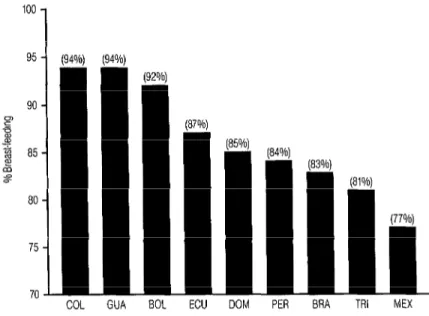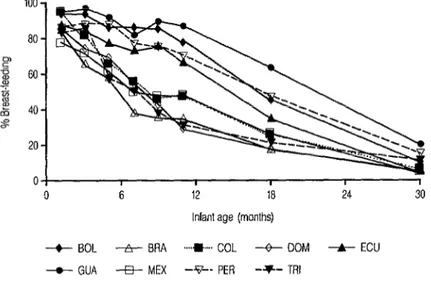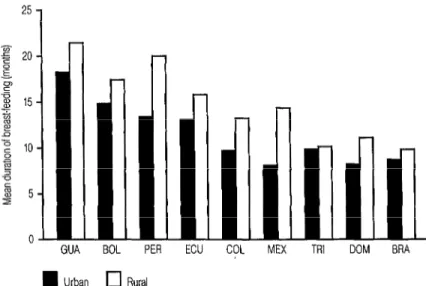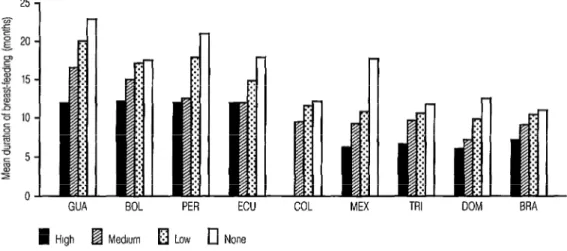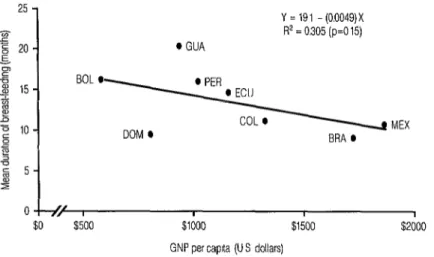Breast-feeding
Patterns in Nine Latin
American and Caribbean Countries1
RAFAEL PEREZ-ESCAMILLA*
444
This arficle uses data from demographicand health surveys carried out in nine Latin American and Caribbean countries between 1984 and 1988 to compare breast-feeding patterns in those countries, where findings indicate that 6% to 23% of the infants are not breast-fed beyond
fwo months of age. Although wide variations in breast-feeding patterns occurred, a number of general trends were noted.
To begin with, the mean rate of breast-feeding declined relatively fast in one group of
countries (Brazil, Coloml ia, the Dominican Republic, Mexico, and Trinidad and Tobago), where half the infants surveyed had been weaned from fhe breast well before their first birthday. This differs from the situation found in the otherfour countries (Bolivia, Guatemala, Ecuador, and Peru), where half the infants were still being breast-fed during their second year of life,
Within each of the nine countries, the mean breast-feeding duration was longer in rural than in urban areas and among women with relatively low levels of education. The direction
of these relationships was similar when analyses were performed across countries. In addition, a strong inverse relationship was found between the percentage of births attended by health workers in the countries surveyed and fhe mean duration of breast-feeding in those countries.
T
he well-documented nutritional, im- munologic, and contraceptive ad- vantages of breast-feeding (I -3) have led international health organizations to rec- ommend the promotion and support of this infant feeding method in developing countries (4). In order to identify which parts of the world are in greatest need of breast-feeding promotion programs, however, it is essential to describe recent breast-feeding patterns in different coun- tries and regions and to compare them with patterns observed in the past. Since breast-feeding rates tend to be unevenly distributed in different socioeconomic and cultural subgroups within a country (5- 8), it is also important to compare breast-IThis article is also being published in Spanish in the Boletin de la Oficina Sanitaria Panamericana, vol. 114, no. 2, 1993.
ZDepartment of Nutrition and Program in Interna- tional Nutrition, University of California at Davis, CA 95616-8669, USA.
feeding patterns in urban and rural areas and among women in different socioeco- nomic groups. In addition, it is important to try and see if there is any relationship between the modern health care system and the degree of successful lactation, due to the potential role that the health care system can play in improving breast- feeding rates worldwide (9, 20).
Exclusive breast-feeding is defined as the infant feeding method employing breast milk as the infant’s only food. Since the risk of morbidity increases among in- fants given fluids by bottle, even if they are breast-fed (11), and since the risk of conception decreases substantially among mothers who practice exclusive breast- feeding (3), this method has been rec- ommended for infants O-4 months of age (4, 20). For this reason among others, it is important to document the data avail- able on rates of exclusive breast-feeding in developing nations.
This article focuses on breast-feeding
patterns in Latin America and the Car- ibbean. Assessment of the recent breast- feeding situation in this part of the world is important, because surveys done about a decade ago indicated that breast-feeding performance in this region was substan- tially worse than in the world’s other de- veloping areas (7). The specific aims of this presentation are (1) to summarize and integrate recent information describing breast-feeding patterns in Latin America and the Caribbean, (2) to compare breast- feeding patterns in different countries, (3) to describe secuIar trends in breast- feeding, (4) to document exclusive breast- feeding rates among infants O-4 months old, and (5) to assess breast-feeding pat- terns within and between countries for certain subgroups (i.e., urban vs. rural dwellers, people with low vs. high so- cioeconomic status, and mothers deliv- ering infants by traditional vs. modern methods).
MATERIALS
AND METHODS
Information
Retrieval
Two computerized literature banks, Medline and Current Contents, were used to identify published results from recent demographic and health surveys (DHS) conducted in Latin America and the Car- ibbean. Nine surveys involving seven Latin American countries (BoIivia, Brazil, Colombia, Ecuador, Guatemala, Mexico, and Peru--12-28) and two Caribbean countries (the Dominican Republic and Trinidad and Tobago--19, 20) were identified.
The World Fertility
Survey (WFS)
and DHS Surveys
A lack of nationally representative breast-feeding data was partly overcome by the WFS begun in the early 1970s (7). Since 1984 the DHS have replaced the
WFS and have become a key source of information on infant feeding practices around the world. This effort has been funded by the United States Agency for International Development and carried out by subcontractor agencies such as the Population Council and the Institute for Resource Development/Macro Inter- national in conjunction with local governments.
As indicated above, the assessment presented here is based on data from those Latin American and Caribbean countries found to have published DHS informa- tion. The breast-feeding results from the nine countries identified are readily com- parable because all nine demographic health surveys were based on represen- tative cross-sectional samples of the na- tional population, employed similar ma- ternal age ranges, were conducted during the second half of the last decade (1986- 1989), and reported their results in nine country reports (12-20) compiled by the Population Council and the Institute for Resource Development/Macro Interna- tional that employed a standardized format.
Statistical Analyses
Comparisons of relationships in differ- ent countries between breast-feeding and urban versus rural residence, economic productivity, and contact with the mod- ern health care system were analyzed by linear regression (21).
Definitions
Since breast-feeding rates at birth were not reported in isolation, the proportion of infants initiating breast-feeding has been defined for purposes of this analysis as the proportion of infants who were breast- fed between birth and 2 months of age. The term breast-feeding implies that the infant received breast milk alone or in
combination with other foods. In seven of the surveys (12-15, 17-19) the re- ported mean breast-feeding duration was estimated taking into account the breast- feeding prevalence reported at each age interval between birth and 36 months of life. Since the mean breast-feeding du- ration was not reported for Guatemala (16) or Trinidad and Tobago (20), esti- mation of this parameter was based on the proportion of urban and rural dwell- ers included in the survey and on the mean breast-feeding duration reported for urban and rural areas in these two coun- tries (16, 20, see Table 1 footnote).
RESULTS
Initiation
and Duration
of Breast-
feeding
The data in Figure 1 indicate that the observed rate of initiation of breast-
feeding, as defined above, ranged from a low of 77% in Mexico to a high of 94% in Colombia and Guatemala.
As indicated in Table 1, the surveys found that the mean duration of breast- feeding ranged from 9.2 months in Brazil to 20.2 months in Guatemala. Guatemala also tended to have the highest preva- lence of breast-feeding throughout the first 3 years of life (Figure 2). In general, the breast-feeding patterns of Bolivia and Guatemala tended to be fairly similar for infants in the first 9 months of life, after which the prevalence of breast-feeding declined considerably faster in Bolivia.
The Figure 2 data also show that in- fants in five countries (Brazil, Colombia, the Dominican Republic, Mexico, Trini- dad and Tobago) experienced a relatively rapid decline in breast-feeding rates dur- ing the first year of life. In these countries the median duration of breast-feeding among infants that were ever breast-fed
Figure 1. Breast-feeding prevalences found among infants O-2 months of age in each of the survey countries. The sample size of infants in this age range in each country was as follows: Bolivia 152, Brazil 82, Colombia 83, the Dominican Republic 138, Ecuador 74, Guatemala 146, Mexico 125, Peru 79, and Trinidad and Tobago 43. Data sources: references 12 -20.
100
1
95 -
90 -
a5 - 80 - 75 - 7” - J”
COL GUA BOL ECU DOM PER BRA TRI MEX
Table 1. Mean breast-feeding durations in the nine survey countries.
Year of data collection
No. of survey children
O-36 mo
Uran PIUS rural
Mean breast-feeding duration (months)
Rural Urban
Guatemala 1987 2 797 20.2” 21.5 18.1
Bolivia 1989 3 554 16.2 17.4 14.8
Peru I986 1 796 16.0 20.0 13.4
Ecuador 1987 1 861 14.5 15.8 13.1
Colombra 1986 1 605 11.1 13.2 9.7
Mexico 1987 3 452 10.5 14.4 8.2
Trinidad and Tobago 1987 1 138 10.1” 10.3 9.9
Dominican Republic 1986 2 668 9.3 10.7 8.4
Brazil 1986 1 960 9.2 9.9 8.8
dMean breast-feeding duration was not reported for Guatemala or Trinidad and Tobago. Estimations of the mean breast-feeding durations In these two countrles were dewed by applying the following formula:
5 = XJBF,) + X,(&F,)
Where E = mean breast-feedmg duration; X, = proportion of subjects interwewed who were living in urban areas; X, = proportion of subjects interviewed who were lwing in rural areas; BF, = breast- feeding duratton In urban areas; BF, = breast-feeding duration in rural areas.
ranged from 6.6 months in Brazil to 8.9 (Bolivia, Ecuador, Guatemala, Peru) ex- months in CoIombia (22). The substantial perienced a much slower decline in breast- decline in breast-feeding in Brazil during feeding rates during the first year of life. the first six months of life is especially The median duration of breast-feeding in noteworthy. these countries ranged from 13.9 months in Infants in the remaining four countries Ecuador to 20.8 months in Guatemala (22).
Figure 2. Breast-feeding prevalences among survey children in each of the study countries at six-month intervals over the first three years of life. The sample size in each country of survey children O-36 months old is shown in Table 1. Data sources: references 12-20.
loo- 80 - 20 -
01 I I I
0 6 12 18
Infant age (months)
24 30
--+- BOL +I- BRA --W- COL + DOM -A- ECU
-o- GUA -E+ MEX -T-- PER -+- TRI
Secular Changes in Breast-feeding
Duration
Changes in the duration of breast-feed- ing over time in different countries have been documented by Sharma et al. (23), who compared the median breast-feed- ing durations found by the demographic health surveys with those found by the world fertility surveys conducted about a decade earlier. Their results indicated that the secular trends were not consistent across countries. While large increases in the mean breast-feeding duration were ob- served in Trinidad and Tobago (+2.9 months) and Peru ( + 1.3 months), Ecuador ( + 0.3 months) exhibited only a small in- crease, the situation in Mexico remained essentially unchanged, and Colombia and the Dominican Republic experienced de- clines of -0.3 month and -1.3 months, respectively. No data were reported for Bolivia, Brazil, or Guatemala.
Urban vs. Rural Patterns
The survey data shown in Figure 3 and Table 1 indicate that in all nine countries the breast-feeding rates were lower in ur- ban than in rural areas. It can also be seen that the better lactation performance observed in Guatemala was due to a longer mean breast-feeding duration in both ur- ban and rural areas relative to the other countries.
Figure 4 depicts the inverse relation- ship found between mean breast-feeding duration and the percentage of the pop- ulation living in urban areas in each of the nine countries. From the slope of the regression equation it can be estimated that a 15% rise in urbanization-repre- senting the mean of the difference be- tween the lower (38%) and upper (68%) range of urbanization-was associated with a 3.6-month decline in the mean
duration of breast-feeding.
Figure 3. A country-by-country comparison of the mean duration of breast-feeding in urban and rural areas. Data sources: references 12-20.
GUA BOL PER ECU CDL
r
l-l
MEX TRI DOM BRA
36
n
Urban 0 RuralFigure 4. The relationship between mean breast-feeding duration in each of the survey countries and the degree of urbanization in each country, showing a decline in the duration of breast-feeding with increasing urbanization. Data sources: references 12-20.
l GUA
Y=265-(0241)X RZ = 0.417 (p=OO6)
0 I I I I I I 1
0 35 40 45 50 55 60 65 70
% Urbanrzation
Socioeconomic
Status
breast-feeding in every country. Womenwith little or no formal education tended As indicated in Figure 5, an inverse to breast-feed their infants longer than relationship was found between mater- women who received more advanced nal education and the mean duration of schooling.
Figure 5. The relationship between mean breast-feeding duration of the survey children and maternal education in each of the countries studied. None = no formal education; low = little formal education; med = a moderate level of formal education; and high = a high level of formal education. The definitions of low, medium, and high levels of formal education varied in the different survey countries. Only three education categories were reported for Colombia. Data sources: references 12-20.
GUA BOL PER ECU COL MEX TRI OOM ERA
1 High I Medrum 1 Low 0 None
Figure 6. The relationship between mean breast-feeding duration in each of the survey countries and a measure of economic productivity (GNP per capita) in that country. Trinidad and Tobago was not included because per capita GNP there was about five times greater than in the other countries. The years of the GNP estimates shown are 1984 for Brazil; 1985 for Colombia, the Dominican Republic, and Peru; 1986 for Ecuador, Guatemala, and Mexico; and 1988 for Bolivia. Data sources: references 12 -20.
l GUA
Y = 191 - (0.0049)X I32 = 0.305 (p=O 15)
MEX
DOM * BRA @
o-h7 I
$0 $500
, I 1
$1000 $1500 $2000
GNP per capita (US dollars)
Figure 6 shows the anticipated inverse relationship between mean breast-feed- ing duration and economic productivity (GNP per capita) in eight of the nine countries. It should be noted, however, that the slope of the regression coefficient did not differ significantly from zero (p = 0.15), perhaps due to the small sample size.
Health Care Systems
Figure 7 depicts the inverse relation- ship observed between mean breast- feeding duration and the percentage of births attended by health workers in each of the nine countries. It is important to note the strong linear relationship be- tween these two variables. In this same vein, the percentage of the variance in breast-feeding explained by the propor-
tion of deliveries attended by health care personnel was 88%. From the slope of the regression equation, it is possible to estimate that a 34% increase in the pro- portion of infants delivered by trained health care workers-which represents the mean of the difference between the lower (29%) and upper (98%) range in the proportion of deliveries attended by health care personnel-is associated with a 5.5-month reduction in the mean du- ration of breast-feeding.
Exclusive Breast-feeding
The data shown in Figure 8 reveal that
rates of exclusive breast-feeding during the first four months of life in eight of the nine countries were far below the de- sired lOO%, ranging from 3% in Brazil to 55% in Bolivia.
Figure 7. The relationship between mean breast-feeding duration in each of the survey countries and the proportion of births attended by health workers in that country, showing a decline in the duration of breast-feeding with increasing birth attendance by health workers. A health worker was defined as a trained nurse or physician. In the case of Brazil, delivery in a hospital/clinic (rather than home delivery) was considered a birth attended by health workers. In the Dominican
Republic and Trinidad and Tobago trained midwives were included in the “health worker” classification because births attended by nurses and trained midwives were reported as a single category. Data sources: references 12-20.
Y = 23.6 - (0161)X RZ= 0.877 (p=O.O002)
”
0 30 4'0 5; 6; i0 io ;0 lb0
% Births attended by health workers
Figure 8. A country-by-country comparison of the prevalence of breast- feeding (BF) and exclusive breast-feeding (EBF) in eight of the survey countries among infants O-4 months of age. The data shown include only infants breast-fed during the 24 hours preceding data collection. Data source: reference 26. Data for Guatemala were not reported.
100
80
8 60
2? g
22 40
20
0
I I
EOL
n
Et3F1
I
_I
DOM
ECU COL
I
TRIPER
q BF
MEX BRA
DISCUSSION
As was perhaps to be expected, wide variations were found in the breast-feed- ing patterns observed in the nine Latin American and Caribbean countries sur- veyed. Rates of initiation of breast-feed- ing ranged from 94% (in Guatemala and Colombia) to 77% (in Mexico). The mean breast-feeding duration varied from a high of 20.2 months in Guatemala to a low of 9.2 months in Brazil. Secular trends in mean breast-feeding duration also var- ied, with some countries recording sub- stantial increases in lactation perfor- mance while others experienced declines. Future studies should attempt to identify the principal factors responsible for the diversity of these secular trends observed in different countries.
The prevalence of exclusive breast- feeding also varied. However, in all cases the proportion of women practicing this feeding method was far below optimal, indicating that promotion of exclusive breast-feeding in the survey countries should continue to receive priority.
Comparison of situations prevailing in the different countries pointed to several general breast-feeding patterns. First, certain countries experienced a steep de- cline in breast-feeding rates during the first year of life; in these countries half of the infants surveyed had already been weaned from the breast well before their first birthday. In contrast, certain other countries experienced a less pronounced decline in breast-feeding rates during the first year of life but a relatively steeper decline during the second and third years of life. Among these latter countries, about half of the infants surveyed were weaned from the breast during the second year of life.
Second, women with higher levels of education (indicating higher socioeco- nomic status) within each country tended to breast-feed for shorter periods of time
than did their less educated counter- parts. An inverse relationship between mean breast-feeding duration and socio- economic status was also apparent in the comparisons between countries. These findings are in agreement with the re- sults of studies and surveys carried out more than a decade ago in developing countries (5-8).
Third, the mean duration of breast- feeding within each country was longer among rural than among urban dwellers. This finding, which also tended to emerge from the cross-country comparisons, is likewise in accord with the above- mentioned earlier studies (5-8).
Fourth, a strong inverse linear rela- tionship was found between the duration of breast-feeding and the proportion of deliveries that took place within the mod- ern health care system. This suggests that the health care system may not be con- tributing to improved lactation perfor- mance in Latin America and the Carib- bean. This matter deserves special attention, particularly because several of the countries surveyed (9, 10) have al- ready put in place large-scale breast-feed- ing promotion programs in which the heaIth care system plays a major role. It is possible that several of these programs had not been fuI1y implemented or had not had a chance to have a national im- pact on breast-feeding practices by the time the DHS survey was conducted. It is aIso important to emphasize that as- sociation does not prove causation, and that within-country data and controlled experimental studies are needed in order to better understand what influence the health care system is having upon ma- ternal infant feeding choices.
CONCLUSIONS
While the present assessment points to wide variations in the breast-feeding pat- terns of Latin America and the Carib-
bean, some findings were similar in every country surveyed. These similar findings included an inverse relationship between the mean duration of breast-feeding and socioeconomic status, and also an inverse relationship between the mean duration of breast-feeding and the degree of ur- banization. Moreover, across-country comparisons suggested that some of the differences in breast-feeding patterns in different countries might have been due to country-level differences in national economic productivity and degree of ur- banization. As Popkin has noted else- where (7),
Urban areas are more densely populated, have better transport networks, have a more hectic life, more social services, more com-
mercial food outlets . . _ and [maternal] work may be less compatible with child care.
Recent trends suggest that 80% of the population in Latin America will be living in urban areas by the year 2000 (24, 25).
Therefore, it is important that future studies continue attempting to identify components of urban life responsible for the negative relationship between urban
living and breast-feeding within each country. This will help provide a basis for interventions capable of effectively
promoting breast-feeding; and in this and
other ways it will contribute to prevent- ing further declines in lactation perfor- mance in countries with high proportions of rural dwellers that are becoming in-
creasingly urban.
Finally, it seems clear that the potential role for the modern health care system as a promoter of breast-feeding world- wide is enormous and will continue to grow as more births in developing coun- tries take place within the system. For this reason, the strong inverse relation- ship found between delivery of an infant by trained health care workers and breast- feeding duration deserves to be studied in detail.
REFERENCES
1. 2. 3. 4. 5. 6. 7. 8. 9. 10. 11. 12. 13. 14. 15.Pierse I’, Van Aerde J, Clandinin MT. Nu- tritional value of human milk. Prog Food Nutr Ski. 1988;12:421-447.
Jason JM, Neiburg I’, Marks JS. Mortality and infectious diseases associated with infant feeding practices in developing countries. Pediatrics. 1984;74:702-727. Howie PW. Breast-feeding: a natural method for child spacing. Am J Obstet Gy- necol. 1991;165(suppl):1990-1991.
Anon. Inoccenti declaration on the pro- tection, promotion, and support of breast- feeding. Ecol Food Nufr. 1991;26:271-273. Winikoff B, Laukaran V. Breast-feeding and bottle-feeding controversies in the developing world: evidence from a study in four countries. Sot Sci Med. 1989;29:859- 868.
Winikoff B, Castle M, Laukaran V, eds. Feeding infants in four societies: causes and consequences of mothers’ choices. Connecti- cut: Greenwood Press; 1989.
Popkin BM, Bilsborrow RE, Akin JS, Ya- mamoto ME. Breast-feeding determinants in low-income countries. Med Anthropol. 1983;7:1-31.
Forman MR. Review of research on the factors associated with choice and dura- tion of infant feeding in less developed countries. Pediafrics. 1984;74:667-693. Jelliffe DB, Jelliffe PEF, eds. Programmes fo promote breast-feeding. New York: Ox- ford University Press; 1988.
Labbock M, McDonald M, eds. Proceed- ings-of the Interagency Workshop on Health Care Practices Related to Breast- feeding. Int J Gynecol Obstef (suppl). 1990;31:31-34.
Brown KH, Black RE, Lopez de RomaAa G, Kanashiro HC. Infant feeding practices
and their relationship with diarrhea1 and
other diseases in Huascar (Lima), Peru. Pediatrics. 1989;83:31-40.
Anon. Bolivia 1989: results from the De- mographic and Health Survey. Stud Fam Plan. 1991;22:272-276.
Anon. Brazil 1986: results from the De- mographic and Health Survey. Stud Fam Plan. 1988;19:61-65.
Anon. Colombia 1986: results from the Demographic and Health Survey. Stud Fam Plan. 1988;19:305-309.
Anon. Ecuador 1987: results from the De-
mographic and Health Survey. Stud Farn Plan. 1989;20:117-121.
16. Anon. Guatemala 1987: results from the Demographic and Health Survey. Sttld Fam Plan. 1990;21:55-59.
17. Anon. Mexico 1987: results from the De- mographic and Health Survey. Stud Fam Plan. 1990;21:181-185.
18. Anon. Peru 1986: results from the De- mographic and Health Survey. Sfud Fum Plan. 1988;19:191-195.
19. Anon. Dominican Republic 1986: results from the Demographic and Health Sur- vey. Stud Fam Plan. 1988;19:122-126. 20. Anon. Trinidad and Tobago 1987: results
from the Demographic and Health Sur- vey. Stud Fam Plan. 1989;20:235-239. 21. SAS Institute. SASISTAT user’s guide (6.03
ed.). Cary, North Carolina: SAS Institute; 1988.
22. Anderson MA. Nature and magnitude of the problem of suboptimal breast-feeding practices. Paper presented at the Inter- national Policymakers’ Meeting on Breast-
feeding. Florence, Italy: 30 July-l August 1990.
23. Sharma R, Rustein SO, Labbok M, Ramon G, Effendi S. A comparative analysis and differentials in breast-feeding: findings from DHS surveys. Paper presented at the Population Association of America Annual Meeting. Toronto, Canada: May 1990.
24. Solomons NW, Gross R. Urban nutrition in the tropics: a call for increased attention to metropolitan population in the devel- oping world. Food Nufr Bull. 1987;9:43-44. 25. Uauy R, Chauteauneuf R, Valiente S. Food
and nutrition problems in urbanized Latin America: misdirected development. In: White PL, Selvey N, eds. Malnutrition: de- terminants and consequences. New York: Alan R. Liss; 1984:29-43.
26. United States Agency for International Development. Breast-feeding: a report on AID programs, a report to Congress. Washington, DC: May 1990:14-15.
Nursing Research Conference
The First International Conference on Community Health Nursing Re- search will be held in Edmonton, Alberta, Canada, from 27 to 29 Sep- tember 1993. Its focus will be research on nursing interventions related to health promotion and illness and injury prevention services in the community. The conference aims to provide an international forum for exchange of ideas and information about these areas of community health nursing research; to produce conference proceedings that will be useful to practitioners, educators, researchers, and policy makers; and to expand community health nursing networks.
For further information on the conference, contact Dr. Shirley Stin- son or Ms. Karen Mills, International Conference on Community Health Nursing Research, Edmonton Board of Health, Suite 500, 10216 - 124 Street, Edmonton, Alberta, T5N 4A3, Canada; telephone (403) 482-1965; fax (403) 482-4194.
